
Monuments and Sculpture Pay Homage to History in the Art Nouveau City of Ålesund Norway
Excerpts from Wikipedia Creative Commons‘ CC BY-SA
Visitors to Ålesund can not but be struck by the spectacular beauty of the cities architecture, a result of the rebuilding efforts after a devestating
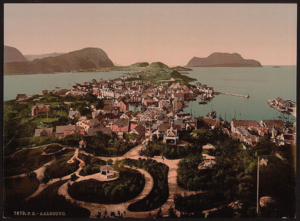
Public Domainview terms
File:General view, Alesund, Norway.jpg
Created: between 1890 and 1900
1904 fire. But art abounds in many forms throughout this historically seafaring city. Its not hidden but can be overlooked if you narrow your focus to just the things that relate to Jugendstil. The following are some examples you may run across.
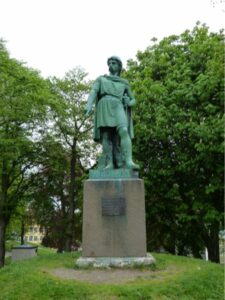
Legend has it that Gangerolf (outside of Norway better known as Rollo), the 10th-century founder of the dynasty of the dukes of Normandy, hailed from the community of Giske, north-west of Ålesund. At least three statues of Rolle exist: in the town park in Ålesund, in the city of Rouen, France, and in Fargo, North Dakota, United States.
In 1835, Ålesund had 482 inhabitants. By 1900, the population had increased to 11,777.
In the night of 23 January 1904, the town was the scene of the Ålesund Fire, one of the most terrible of the many conflagrations to which Norwegian towns, once built largely of wood, have been subjected. Practically the entire town was destroyed during the night, a gale
aiding the flames, and the population had to leave the town in the middle of the night with only a few minutes’ notice. Only one person died in the fire, the 76-year-old Ane Heen, but more than 10,000 people were left without shelter.
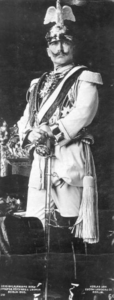
File:Wilhelm II. 1905.jpeg
Created: 1 January 1905 Reichard & Lindner; publisher: Gustav Liersch & Co. – http://www.dhm.de/lemo/objekte/pict/95007746/index.html
Kaiser Wilhelm of Germany had often been on vacation to Sunnmøre. After the fire, he sent four warships with materials to build temporary shelters and barracks. After a period of planning, the town was rebuilt in stone, brick, and mortar in Jugendstil (Art Nouveau), the architectural style of the time. The structures were designed by approximately 20 master builders and 30 Norwegian architects, most of them educated in Trondheim and Charlottenburg, Berlin, drawing inspiration from all over Europe. To honor Wilhelm, one of the most frequented streets of the town is named after him.
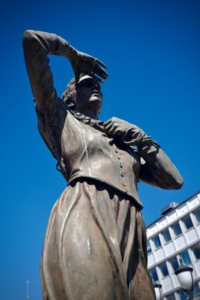
The town has an unusually consistent architecture, most of the buildings having been built between 1904 and 1907. Jugendstilsenteret is a national interpretation centre, visitors can learn more about the town fire, the rebuilding of the town and the Art Nouveau style. Ålesund is a partner in the Art nouveau network, a European network of co-operation created in 1999 for the study, safeguards and development of the Art nouveau.
The term “Little London” was often applied to the community during the occupation of Norway by Nazi Germany due to the Norwegian resistance work that took place here. Among other things, the city was central to the flights to Scotland and England.
The colorful harbor area of town or the “Brosundet” showcases even more in the way of historical sculpture. In Ålesund there is the “Seaward” memorial”, which remembers a fishing disaster off the coast of Ålesund in 1885. The plaque on the base of the memorial reads:
“On August 13 1885, 7 open fishing boats sank in a severe north-westerly gale off the coast of Ålesund. 33 fishermen lost their lives. 29 widows and 113 children were left to mourn.” “Seaward” was erected in memory of those who died in the tragedy.
Most of the 33 fishermen were from Buholmen, Buholmstranda and Røysa, the nearby area to the east of the monument. “Seaward”, therefore, stands also as a tribute to the proud and thrifty fisher folk who lived in this part of Ålesund.”
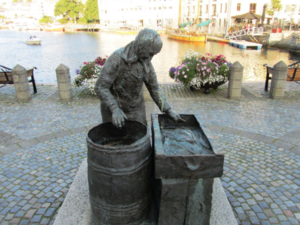
The Herring Wife is a lifelike tribute to those women who worked at salting herring, which was one of the town’s main industries.